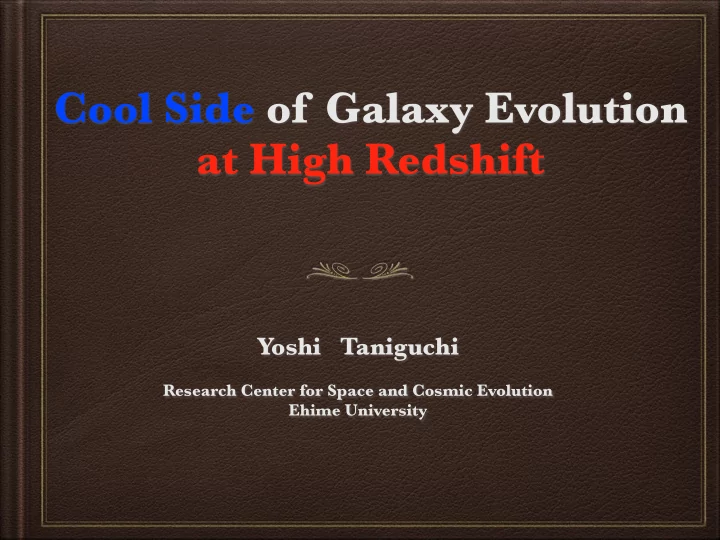

Cool Side of Galaxy Evolution at High Redshift Yoshi Taniguchi Research Center for Space and Cosmic Evolution Ehime University
Not Paul Newman but Yoshi Taniguchi Here is a galaxy What will happen ? Not a hustler, but an astronomer !
A superwind occurs !
H I Absorption-line systems in the Universe (http://enki.phyast.pitt.edu/qso_abs.html)
H I Absorption-line systems in the Universe Damped Ly α Absorption System: DLA - N (H I ) > 2 x 10 20 cm -2 Lyman Limit Absorption System: LLS - N (H I ) ~ 10 19 cm -2 Ly α Forests: N (H I ) < 10 17 cm -2 What are DLAs ?
H I Absorption-line systems in the Universe galaxy ? DLA (http://enki.phyast.pitt.edu/qso_abs.html)
Lesson r = 5 kpc & M (HI) = 10 9 M sun V ~ 2 x 10 67 cm 3 a spherical N (HI) = M (HI)/ m p galaxy ~ 1 x 10 66 atoms n (HI)= N (HI)/ V ~ 0.05 cm -3 N (HI) = n (HI) x 2 r ~ 3 x 10 21 cm -2 Oh, DLAs must be galaxies !
Predictions of galaxy models for DLAs 1. Impact parameters should be less than several kpc 2. We could easily identify a galaxy as a counterpart However .....
Observational properties of DLAs are far from the predictions 1. Impact parameters are large up to several 100 kpc 2. Detection rate of counterparts is only 10 % (e.g., Wolfe+06, ARAA, 43, 861) Something wrong !
Another option
Superwind Model for DLAs (Taniguchi & Shioya, 00, ApJ, 532, L13 [TS00]; 01, ApJ, 547, 146 [TS01]) Originally, proposed to explain 1. Origin of Ly α blobs (TS00) 2. Origin of chain galaxies (TS01) But, also explains origin of DLAs
Superwind Model for DLAs (Taniguchi & Shioya, 00, ApJ, 532, L13 [TS00]; 01, ApJ, 547, 146 [TS01]) observer quasar Host shocked cool shell formed by a superwind
Properties of shocked cool shell - 1 (Taniguchi & Shioya, 00, ApJ, 532, L13 [TS00]; 01, ApJ, 547, 146 [TS01]) Initial starburst in L * galaxy at z =5 Superwind causes shocked shell T shell =2.1 Gyr ( z shell = 1.6) cooling time R shell = 160 kpc (large impact parameter) N (HI) shell = 1.5 x 10 20 cm − 2 (good for DLAs) Z shell = 4 x 10 − 4 (note that Z IGM = 2 x 10 − 4 ) Chemical abundance pattern: Type II SNe driven ~ consistent with that in DLAs (a flat universe with Ω m =0.3, Ω Λ =0.7, & h = 0.7)
Properties of shocked cool shell - 2 (Taniguchi & Shioya, 00, ApJ, 532, L13 [TS00]; 01, ApJ, 547, 146 [TS01]) Shell width: Δ R shell ~ 24 kpc 160 Velocity dispersion: Δ v shell ~ 160 km s -1 Δ v observed for DLAs (Wolfe+06, ARAA, 43, 861)
Predictions of Superwind Model for DLAs (Taniguchi & Shioya, 00, ApJ, 532, L13 [TS00]; 01, ApJ, 547, 146 [TS01]) 1. N (HI) is okay 2. Large impact parameters Also, explains small values 3. Metallicty is consistent 4. Abundance pattern is consistent 5. Velocity dispersion is consistent & Since host galaxies evolved passively, R ~28 they are too faint to be detected. Everything is fine !!!
Let’s go to DLAs with ALMA
Ideal case for SHOCKED SHELL [CII] mapping of proximate DLA of SDSS J124020.91+145535.6 @ z = 3.1
Proximate DLA of SDSS J124020.91+145535.6 @ z = 3.1
Superwind model for Proximate DLA of SDSS J124020.91+145535.6 @ z = 3.1 -2000 km s -1 +2000 km s -1 ( Hennami+ 09, ApJ, 693, L49) Not Ly α emission but undamped part of continuum
Observational Strategy
We will see a fantastic firework at high redshift
Recommend
More recommend